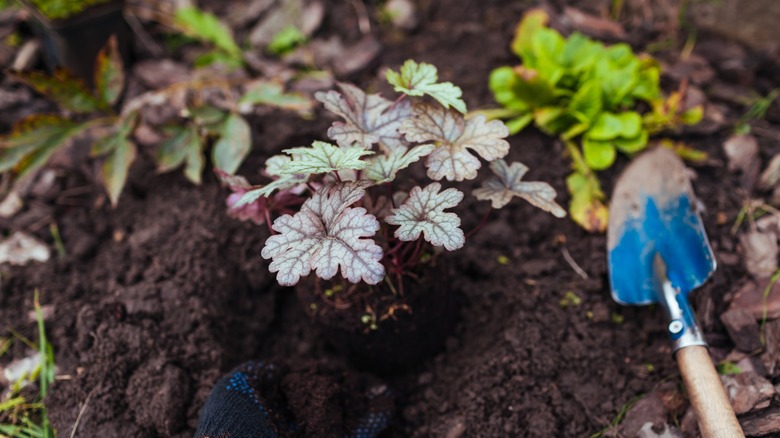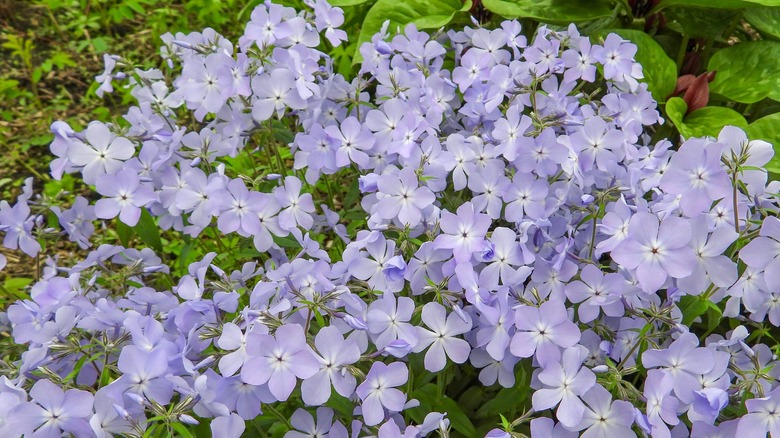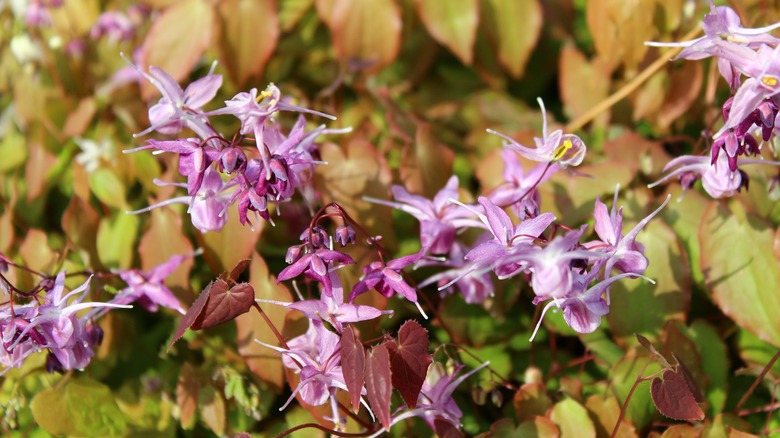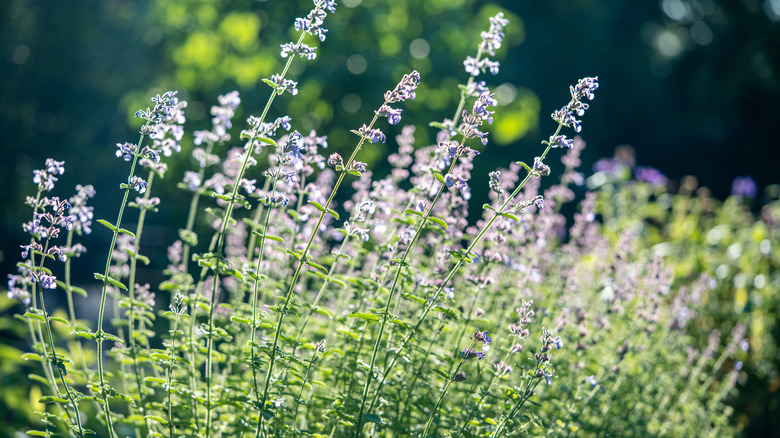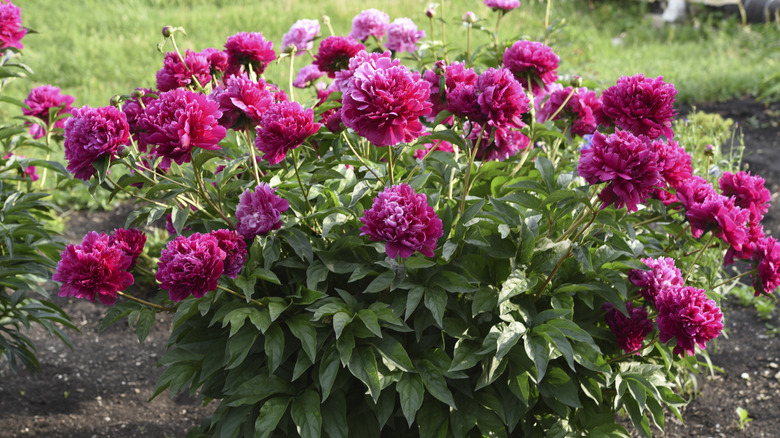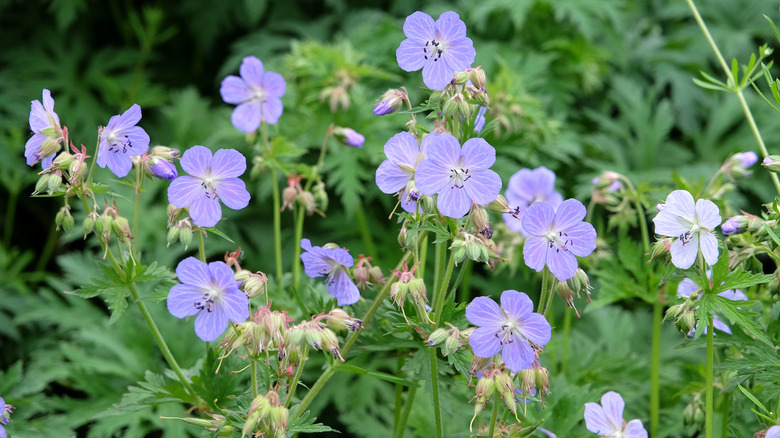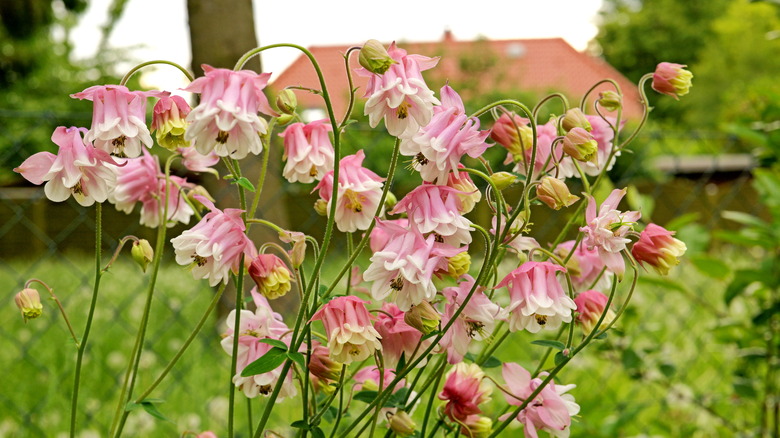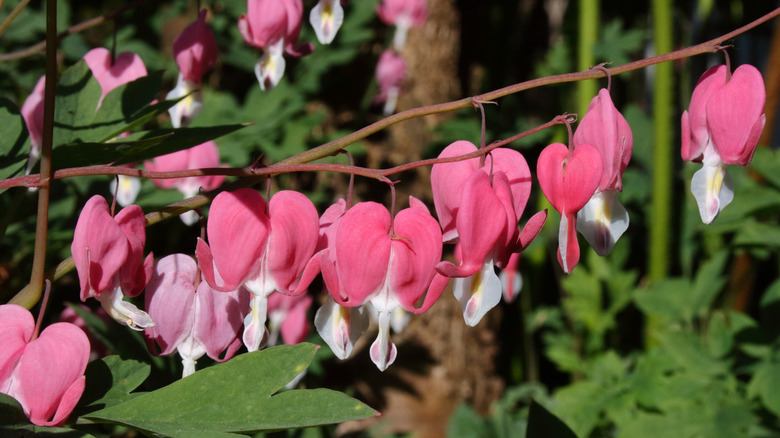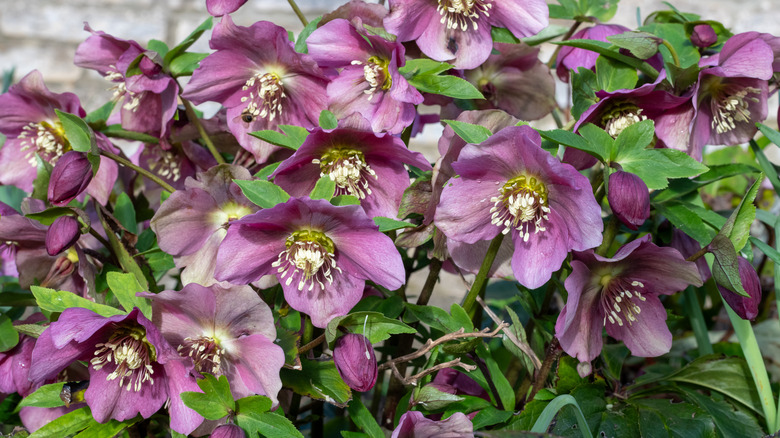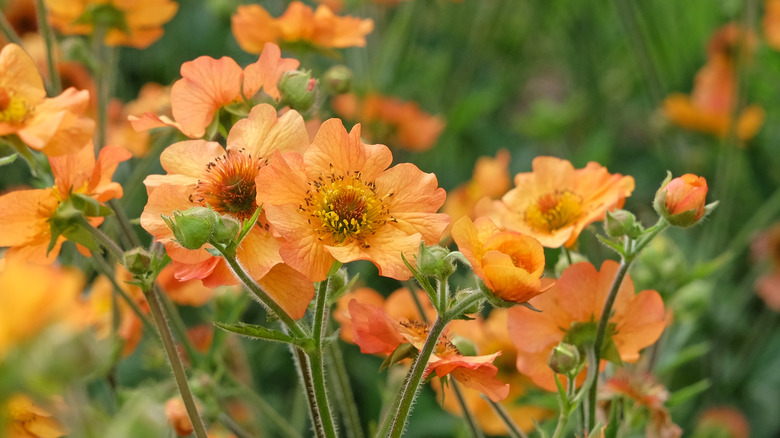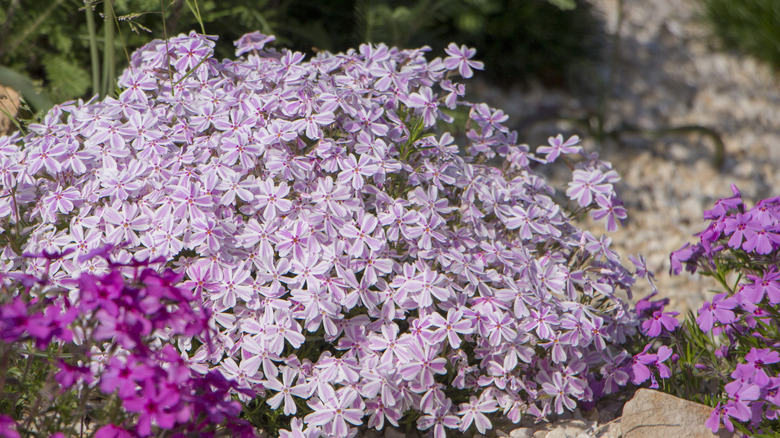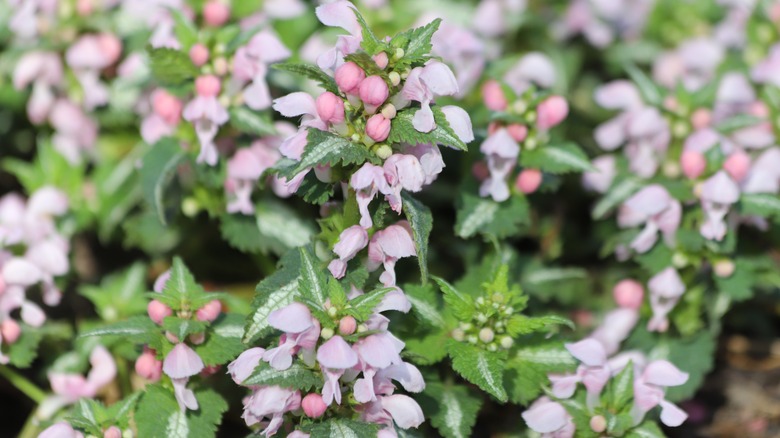15 Perennials You Can Plant In November For A Luscious Spring Garden
Believe it or not, many gardeners continue to plant perennials well into the fall. Many bulb varieties can still be planted as late as November, including tulips, hyacinths, bluebells, grape hyacinths, scilla, and crocuses. Summer-blooming perennials, such as bee balm, Shasta daisies, daylilies, and coneflowers, are often divided and planted in November. But did you know November is also a good time to plant spring-blooming perennials? In my professional gardening work, I'm often planting right up until Thanksgiving week, weather permitting. Here we'll go over some of my favorite perennials that you can plant in November for a gorgeous spring garden.
Spring-blooming perennials are typically robust and resilient, investing energy in spring buds that burst forth in April and May. This robust, cold-hardy nature means they're sturdy enough to be planted in November when they're dormant. Plant them as you would at any other time of year: they still need to be watered, and a light layer of mulch will help protect the roots as they settle in over the winter. It's best not to plant if the forecast shows several consecutive nights with temperatures below freezing, though, so I always keep a close eye on the weather.
Autumn is a busy time in the garden, making it an ideal opportunity to plan the layout for the next season. Planting in November helps you get a head start on making some changes, whether you're dividing established perennials or bringing in new ones (gotta love those end-of-season sales). Also, if you're planting long-lived bulbs at the same time, you can plan out your spring garden for non-stop blooms.
Woodland phlox
Woodland phlox (Phlox divaricata) is a sturdy perennial that blooms in mid-spring for several weeks, in shades of white, pale blue, or lavender. The plants increase every year and are easy to divide in the fall. Once the flowers fade, the glossy green leaves remain, forming dense root clumps that resist weeds. They bloom in sun or partial shade, and are lovely planted alongside perennials that emerge in late spring. They also pair well with various spring-blooming bulb clumps (like daffodils and grape hyacinths).
Coral bells
Coral bells (Heuchera) are a great perennial that provides three seasons of vibrant color. The variety of colors and leaf shapes is simply amazing. Their leaves sometimes fade a bit as the plants go dormant in winter, but new foliage growth appears in spring, followed by the tiny flowers on slender central stems. It's best not to "clean up" the plants too much in the fall when planting, as the fading foliage provides some protection for the roots. Once new growth emerges in spring, you can gently clean away the dead leaves.
Barrenwort
This is a terrific perennial ground cover for shade that blooms in spring and is very low maintenance. The roots form dense mats, so to divide them, you need a shovel or garden knife. Barrenwort (Epimedium) has delicate, lance-shaped green leaves that often have reddish accents. The flowers come in a variety of colors, including pink, white, yellow, and orange. To plant in November, place the division or rooted plant in a shady or partially shaded spot with well-drained soil, and water lightly every few days to help it establish.
Flowering catmint
This pollinator magnet has fragrant violet-blue flowers and attracts honeybees, butterflies, and hummingbirds. Blooming starts in late spring and continues through autumn, as long as you gently shear off the spent flower stems to encourage rebloom and keep the foliage neat. Flowering catmint (Nepeta) increases quickly, and the clumps are easily divided and replanted in November. It blooms best in full sun and likes well-draining soil.
Peonies
Once established, peonies (Paeonia) are long-lived and low-maintenance. These gorgeous spring bloomers benefit from proper planting. Give them full sun, rich, well-drained soil, and some space for air circulation. It's recommended to plant peonies in the fall, well before the first frost, but they can be planted successfully in November: give them a light layer of mulch (shredded leaves or pine straw) to protect the roots. They sometimes take a year to get established before blooming, so be patient. Divide them only as necessary, or every five years.
Cranesbill geraniums
Cranesbill geraniums start forming buds in spring, and some varieties bloom in late spring. These perennial geraniums come in several forms: some have long, sprawling stems with multiple flowers and clumping roots, while others have shorter stems and spread via rhizomes. They bloom in partial shade to full sun, and the five-petalled flowers come in a rainbow of colors, including pinks, blues, and purples. I've divided and replanted various types in late autumn, and they come back reliably in spring, increasing in size each year.
Columbines
Columbines (Aquilegia) are shade-tolerant, long-blooming spring flowers that lend a touch of romantic cottage style. There are many colors and various forms, like the 'Barlow' columbines, which have puffy, spiky blooms. The seeds of different types will often hybridize as they reseed in the garden and give you new color combinations. The tiny seedlings take a couple of years to get large enough to produce flowers. Dividing large clumps or planting new ones in autumn, as late as mid-November, will give you plenty of colorful flowers in spring.
Amsonia
This robust perennial is a reliable spring bloomer for partial shade gardens. It likes a fairly moist but well-drained soil. I've divided my amsonia in both spring and fall, and it's done well in either season. The plant starts to go dormant in late fall, after the leaves have turned bright golden yellow. Though amsonia looks a bit like a shrub in shape and form, it's actually a clumping perennial. Divide it using a shovel or garden knife, and make sure there are several "eyes" on each root division so it will bloom the following spring.
Bleeding hearts
Bleeding hearts (Dicentra spectabilis) are stunning pink perennial flowers that light up a shady garden in spring. The pink heart-shaped flowers come in various shades of pink and white, as well as solid white, and the leaves are shapely and long-lasting. When the leaves start to turn yellow and die, usually around early summer, cut them back. This shrub has a tuberous root that can be cut into pieces and replanted in the fall. Bleeding hearts like a well-drained soil and don't really tolerate full sun.
Hellebore
Also known as Lenten rose, due to their early spring blooming habits, the hellebore is a sturdy, shade-loving perennial that blooms while there's still snow on the ground. Plant these where they can be seen in early spring. The nodding flowers come in a wide range of gorgeous colors, from pale green and yellow to white, pink, purple, red, and even black. They're best planted in full to partial shade, in a well-drained, loamy soil.
Geum
Geums (also called avens) are delicate-looking flowers that bring delightful color to the garden in mid to late spring. The scalloped foliage is also attractive and stays neat all season after the flowers fade. They bloom fine in partial sun and are generally not fussy plants. They can be divided and replanted in autumn and will bloom the following spring. My favorites are 'Totally Tangerine' (delicate golden orange) and 'Pretticoats Peach' (peachy pale yellow flowers edged in pink), for warm pastel colors in the spring flower bed.
Creeping phlox
Creeping phlox (Phlox sublata) is a useful perennial. They have a long period of bloom (late spring through summer), and are great for hard-to-fill areas like slopes and crevices. The thick, matted roots also deter weeds. They benefit from deadheading to keep blooms fresh and remove old and dead foliage; just trim the old raggedy growth back in spring as new growth starts to appear. The colors range from white to pastels and brights in shades of pink, blue, and purple. They like partial to full sun and aren't fussy about soil.
Lady's Mantle
Lady's mantle (Alchemilla mollis) is an easy-care plant that provides months of lush foliage. These hardy shade perennials provide bold chartreuse color in the spring garden when the lacy flower heads burst into bloom in May. The shapely leaves sparkle in the sun after a rain shower. If the spent flowers are deadheaded, you may get a second round of flowers in late summer. Divide lady's mantle in late fall as they start to go dormant. Leave the foliage intact for winter protection, and clean the plants up in spring as new growth emerges.
Dalmatian bellflower
There are many kinds of bellflowers (Campanula) in a range of sizes, shapes, and colors. This particular creeping form is a popular ground cover and rock garden plant. Dalmatian bellflower (Campanula portenschlagiana) has violet-blue bell-shaped flowers that bloom for weeks starting in late spring. Shearing the spent flowers off makes room for more blooms.
Lamium
Spotted dead nettle (Lamium) is a low-growing ground cover that grows well in shady gardens. The two-toned pale green leaves and tiny bell-shaped flowers provide delicate color from late spring through summer. Some varieties have a tendency to spread, but this can be useful if you have a large area in a woodland garden to fill in. They're relatively easy to control, though. The sprawling stems can be trimmed if they get leggy to rejuvenate their growth. My favorite varieties are 'Pink Pewter,' 'Shell Pink,' and 'Orchid Frost.'
